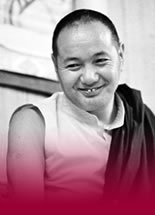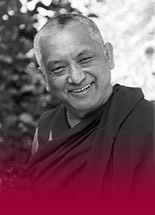Robina’s Blog
5 August, 2021
There are endless books and conferences on exactly that topic. It’s what every living being wants and the wanting of it is the basis of practically every decision we make. It’s primordial.
So, what is it?
Sounds such a simple question. And, from the Buddhist perspective, it is pretty simple – the meaning, that is. But the getting of it – that’s another matter!
The fundamental starting point in understanding it is that it’s a state of mind; it’s in the mind. It is the mind.
In the Buddhist model of the mind, there are three categories of states of mind: positive or virtuous such as love and intelligence; negative or nonvirtuous, or delusional, such as attachment and anger; and those that are neither such as concentration and discrimination.
I like to call the third lot the mechanics of the mind because they’re neither virtuous nor nonvirtuous; a murderer and a meditator both need concentration.
One of the many in this category is called feeling. Don’t think of it as we do, as an equivalent of emotion. There are precisely three kinds of feeling: those that are pleasant or happy; those that are unpleasant or unhappy; and those that are neutral. Pretty straightforward.
We’re all definitely interested in the pleasant and the unpleasant, the happy or the suffering feelings. We spend our lives trying to get the first ones and to avoid the second. And who cares about the neutral!
Clearly there’s a whole range of these, anything from the smallest feeling of pleasure to the most intense level of joy, and the slightest feeling of discomfort to the most intense agony.
So far, not complicated. So why do we find it so hard to be happy? Why do we find it so hard to consistently have pleasant, happy feelings?
Simply, for the Buddha, because we have the wrong analysis of one, what it is and, two, how to get it. That’s the essence of it.
The first mistake is the primordial assumption that the person, the thing or the event is the main cause of the happiness. And this gives rise to the second mistake, that happiness is the thing, the person, or the event. Ask anyone to describe their happiness and they’ll describe the thing, the person or the event. It’s same with suffering.
We’re so addicted to this first belief that we actually conflate the happy feeling in our mind and the external condition.
The first mistake, of course, is called attachment. It drives the universe. For the Buddha, effectively it’s the main cause of all suffering of all sentient beings.
Another mistake we make, especially when we start a spiritual practice, a Buddhist one, let’s say, and we hear that we need to give up attachment, we then conflate attachment and happiness and, as Lama Zopa Rinpoche says, we think, “Oh, I have to give up my happiness, give up my heart?”
No! “The more pleasure, the better!” As Lama Yeshe would tell us.
And yet another mistake we make is that we mix attachment with one of the virtuous states of mind called love. We actually think they’re the same.
So there’s Fred my boyfriend. I love him – that’s a virtue: may he be happy! The more of that, the better! Then I’m totally attached to him – that’s a delusion – thinking that he is the cause of all my happy feelings, so I live in utter misery, terrified of losing him, manipulating him to do what my attachment wants, etc., etc. And then there are some happy feelings.
Love is a virtue. Attachment is a delusion. Happy feelings are neither virtuous nor delusions. Three distinct states of mind. But we get all three mixed up in a big soup of emotion, unable to distinguish one from another.
The job of being a Buddhist – the method for getting happy and stopping suffering – starts with distinguishing between the different states of mind.
And what’s more confusing is that we do actually get happy feelings when we have contact with the attachment object. So what’s Buddha’s problem?
He tells us that, sure, when that delicious cake — the thing — meets my taste consciousness — the mind – happy feelings are definitely triggered. But, he says, these happy feelings are kind of desperate, and they won’t last.
So what’s Buddha’s method for getting happy feelings that aren’t desperate and will last?
The first method is to cultivate virtuous thoughts. Love – the actual virtuous thought of wanting someone to be happy – will trigger happy feelings. That’s great. More of that! More compassion, more kindness, more generosity. They cause happy feelings! Go for it!
Then, finally, the actual method Buddha has discovered that causes happy feelings, pleasure, joy — that will last, that isn’t desperate – is to give up attachment and the root delusion, the one that underpins all the others, including attachment: the assumption of a separate, bereft me.
One step at a time! It’s encouraging to know that it’s possible.

